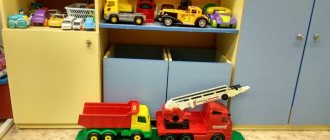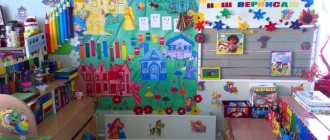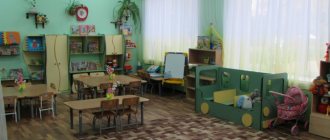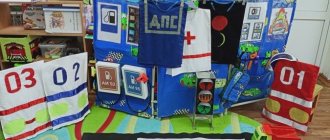Slide captions:
Equipping a speech corner in accordance with the Federal State Educational Standard in the second junior group. Nikiforova A.O. Group No. 13
1.Formation of vocabulary 1. Based on enriching ideas about the immediate environment, continue to expand and activate children’s vocabulary. 2. Clarify the names and purposes of items of clothing, shoes, hats, dishes, furniture, and types of transport. 3. Develop the ability to distinguish and name essential details and parts of objects (for a dress - sleeves, collar, pockets, buttons), qualities (color and its shades, shape, size), surface features (smooth, fluffy, rough), some materials and their properties (paper easily tears and gets wet, glass objects break, rubber toys restore their original shape after being compressed), location (outside the window, high, far away, under the cabinet). 4. Draw children’s attention to some objects that are similar in purpose (plate - saucer, chair - stool, fur coat - coat - sheepskin coat). 5. Develop the ability to understand general words (clothing, dishes, furniture, vegetables, fruits, birds, etc.); name the parts of the day (morning, afternoon, evening, night); name domestic animals and their babies, vegetables and fruits. Objectives of speech development in accordance with the requirements of the modern Federal State Educational Standard:
2. Formation of sound culture of speech 1. Improve children’s ability to clearly pronounce vowels in words (a, u, i, o, e) and some consonant sounds (p - b - t - d - k - g; f - v; t - s - z - c). 2. Develop motor skills of the speech-motor apparatus, auditory perception, speech hearing and speech breathing, clarify and consolidate the articulation of sounds. 3. Develop the correct tempo of speech and intonation expressiveness. 4. Develop the ability to clearly pronounce words and short phrases, speak calmly, with natural intonations.
3. Formation of the grammatical structure of speech 1. Improve children’s ability to coordinate adjectives with nouns in gender, number, case; use nouns with prepositions (in, on, under, for, about). 2. Help to use in speech nouns in singular and plural form, denoting animals and their young (duck - duckling - ducklings); the plural form of nouns in the genitive case (ribbons, nesting dolls, books, pears, plums). Treat children's word creation as a stage of active mastery of grammar, prompt them to the correct form of the word. 3. Help children obtain common ones from common simple sentences (consisting only of a subject and predicate) by introducing definitions, additions, and circumstances into them; make sentences with homogeneous members (“We will go to the zoo and see an elephant, a zebra and tigers”).
4. Formation of coherent speech 1. Develop a dialogical form of speech. Involve children in conversation while looking at objects, paintings, illustrations; observations of living objects; after watching performances and cartoons. Develop the ability to conduct a dialogue with the teacher: listen and understand the question asked, answer it clearly, speak at a normal pace, without interrupting the adult speaking. Remind children of the need to say “thank you”, “hello”, “goodbye”, “good night” (in the family, group). 2. Develop children’s proactive speech in interactions with adults and other children. In order to develop initiative speech, enrich and clarify ideas about objects in the immediate environment, provide children with pictures, books, and sets of objects for independent examination.
It is advisable to place the speech corner next to the book corner. The design of the corner should be aesthetic. Game material must be accessible to the child. Do not overload the corner with equipment. An integral attribute of the speech corner should be a toy - an “animate character”. When organizing a speech corner, the following requirements must be observed:
We use material from the corner of knowledge: D didactic games to develop the ability to distinguish and name essential details and parts of objects (for a dress - sleeves, collar, pockets, buttons), qualities (color and its shades, shape, size), surface features (smooth, fluffy, rough), some materials and their properties (paper easily tears and gets wet, glass objects break, rubber toys restore their original shape after being compressed), location (outside the window, high, far away, under the closet). freshwater”, etc. 1. Formation of a dictionary
2.Sound culture of speech
Grammatical structure of speech Connected speech
Thank you for your attention!
Passport of the speech development center in a general developmental group for children 4 – 5 years old
Passport of
the speech development center
in
a general developmental group
for children 4 – 5 years old
Passport of
the speech development center
in
a general developmental group
for children 4 – 5 years old
In modern preschool education, speech is considered as one of the foundations of raising and educating children, since the success of children’s education at school, the ability to communicate with people and general intellectual development depend on the level of mastery of coherent speech. The development of speech and verbal communication is carried out in all types of children's activities, in different forms. The developmental environment and communication are factors that determine speech development.
The subject-development environment is important for the development of young children who do not yet read, especially in their independent activities. A favorable speech environment develops where there is great interest in books, in reading, where intellectual needs arise and are satisfied.
The Speech Development Center was created with the goal of comprehensive development of the speech of our students.
We have created a Lapbook for speech development “Speech” in which “Cheerful Tongue” lives.
The central canvas presents:
Breathing exercises; a set of cards of pure sayings for different sounds “Developing speech”; Exercise to agree a noun with an adjective “We will speak correctly”; finger games; Articulation gymnastics in pictures - Exercise “Tell a story”; Tongue twisters about animals and birds,
“Tell a story” - mnemonic tables; Exercise “Make a sound” in the form of a train with trailers. There is an animal hidden in each trailer;
Poems about animals; A set of riddles; D/i “The Fourth Wheel”, “Seasons”, “Toys”; Poems about vegetables.
The following sides show:
D/i “Guess from the picture”; Baby's books by rn. fairy tales, nursery rhymes;
Exercises for developing fine motor skills “Games with clothespins”;
Theater "Teremok".
Game exercise for developing fine motor skills - Miracle tree “Harvest”;
Exercise for developing breathing “The breeze blows.”
The center includes and helps solve the following tasks:
Development of articulatory motor skills:
object pictures-supports; articulation patterns; articulatory gymnastics in albums for a specific sound; articulatory gymnastics in poems and pictures.
Development of speech breathing:
Strengthening the correct speech exhalation and developing the ability to control the strength and duration of the air stream.
Card index of games, a set of breathing exercises, examples of games: “Blow a snowflake off your mitten”, “Hot tea”, “Football”, “Whose bird will fly farthest”.
Development of fine motor skills:
Finger gymnastics using poems, songs, nursery rhymes; Massage with finger rubbing and hand massagers; Folk games with palms; Games with natural materials; Games with household items; Strings; clothespins; beads, laces...
Mnemotables:
Mnemonics help young children:
- It is easier to remember poems, tongue twisters, riddles, stories;
- Recode information from visual to abstract and vice versa;
- Build a logical chain of events and reproduce the story in the correct order (beginning - middle - ending);
- Enriches vocabulary;
- Helps develop thinking;
- Develops imagination;
- Helps write long descriptive sentences and coordinate tenses.
A selection of mnemonic tables for memorizing poetry;
Schemes for writing stories;
D/i "Who lives where."
Work on the grammatical structure of speech:
teaching various methods of word formation, the formation of grammatically correct speech.
D/i “Whose Baby”, D/i “Association”, D/i “Professions”, D/i “Tale after Tale”.
“Games for the development of speech in children from 3 to 5 years old”;
D/i “Say a word”, D/i “The fourth odd one”,
D/i “Where, whose baby?”, D/i “Name in one word”,
D/i “Continue the word.”
Replenishing vocabulary:
Activation of vocabulary, generalizing concepts and lexical and grammatical categories. Visually - didactic guide on topics; “Big and small” (used in a diminutive form) “What is made of what”; "Seasons"; "Water transport"; "Air Transport"; "Wild animals"; "Pets"; "Dishes"; "Our house"; "Rules of a small pedestrian";
"Kinds of sports"; "Mushrooms and berries"; "Birds of Russia";
"What is good and what is bad".
The center for speech development
is located next to the bookstore:
Work in this corner contributes to the development of all aspects of the speech system: enrichment of vocabulary, the ability to correctly construct a statement, retell a text, compose descriptive and creative stories.
In the corner there is a selection: portraits of writers;
Poems, fairy tales, stories, r.n. fairy tales, collections of illustrated books.
We play in the theater:
a theater center
with different types of theater
has been created in the group In the dramatization of fairy tales, children learn to construct sentences correctly, transform into different characters, while changing their intonation and voice. Types of theater:
TO
prick theater "Bibabo"; Theater "Rukavichka"; Finger Theater;
Table theater based on the fairy tales “Cat’s House”, “Musicians of Bremen”,
“At the command of the pike”, etc.
Recognition of non-speech sounds:
Card index of musical didactic games; Visually - didactic manual “Musical Instruments”.
Games: “Silence”, “Guess what I’m playing”, “Find out by sound”, “Quiet - loud” and others.
They promote the development of auditory memory and auditory attention, without which it is impossible to teach a child to listen to the speech of others and differentiate phonemes.
At this time, physical hearing works.







